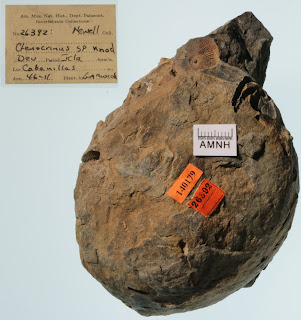Echinoderm project 2023 -Week 6
The final week is here, and it’s x-rays galore!
But before that, the end of last week was also big. That’s because the amazing Christine Siddoway was in town
and stopped by to visit. I (Mohan) and Emory both have her to thank that we are here at all– she’s the one who
put this amazing opportunity out on the Colorado College campus. We celebrated her visit with a New York
classic: Pizza! (Chicago style.) We also took a quick walk into Central Park to admire the view. No, not the city
skyline– the rocks! We found a metamorphic outcrop by a pond with awesome foliations from when it cooled
long ago deep within the earth, and pronounced striations raked over it by glaciers in the last glacial maximum
thousands of years ago. The fossils we’re preparing may come from all over the world, but our walk in Central
Park reminded us that there’s amazing natural history right here in Manhattan as well!
 |
| It's a rock! (courtesy Christine Siddoway) |
This week we finished up the cleaning, photographing, and databasing of the fossils, as well as adding
brand-new labels printed from the online data we’ve been transcribing all these weeks. That brings the
grand total of completed cabinets in Invertebrate Paleontology up by three (hey, every little bit helps).
The main focus, however, was on CT scanning and 3D modeling a fossil of our choice. Monday morning,
we each picked out a presentable little specimen we thought would scan well (how blissfully ignorant we
were back then) and headed over to the room with the CT scanner.
 |
| What mysteries will this unassuming rock hold? We'll never know, I decided to scan a different one. |
 |
| The extremely hi-tech way of packaging the specimen before scanning. |
 |
| Here's our boy, Phoenex. He's a little radioactive :) |
The software had a somewhat steep learning curve and the specimens we picked out turned out to be
less-than-ideal, not to mention the fact that we had to spatially reason with three dimensions on a two
dimensional screen. But we persevered throughout the week, sometimes pivoting and scanning a new
specimen (with no matrix this time), and sometimes throwing up our hands and saying “good enough is
good enough”. The fossil models were soon so pockmarked and bumpy they looked like a swiss-cheese
carving of the original. Luckily, one of the steps involved smoothing and simplifying, so in the end, the
models ended up looking good enough to warrant uploading them into an online database (because we can
never have too many databases, right?). For it being our first foray into CT scanners and 3D modeling, we
made it out okay, and we ended up a lot more knowledgeable about the technical details, as well as the
process of learning difficult (and sometimes frustrating) new skills.
 |
| The digitized fossil model enters corporeal form once again, now with a bit more polymers. |
We also got a tour of a collection with a special place in our hearts, the Geology Department. Our geology
backgrounds are what got us here, so it only makes sense for it to be the last tour of our stay. Most of the
“pretty” rocks (really the gems and minerals) are already on display in the Gems and Minerals Hall, but we
got to appreciate some newly acquired ones, as well as the ones that didn’t make the cut, and the “ugly” ones
that are nonetheless beautiful to researchers and scientists. The Geo collection had just been photographed and
cataloged, and it was partially that work which allowed for the creation of the new exhibit which has all the
pretty rocks occupied right now. It was heartening to see the direct good that can come out of this
behind-the-scenes collection work.
.jpg) |
| All the specimens are organized by chemical formula... except tourmalines. They defy organization. |
 |
| The old school collection catalog |
 |
| They're big, not ugly >:( |
 |
| We're taking pictures of rocks here in an alternate universe |
 |
| Meat rock |
We are all so thankful for the opportunity we have had to contribute to the betterment of the Invertebrate
Paleontology collections at the museum, and by extension, to provide a service to science and the public.
We have learned so much these past six weeks– this is an experience we’ll cherish and take with us as our
educational and life journeys continue to unfold. Remember, anyone can make a difference– one storage
cabinet at a time.
 |
| (Courtesy Christine Siddoway) Special thanks to Bushra for bringing us this amazing opportunity and making our stay at the museum the best it could be. You're the best! |
 |
| Emory taking photographs (Courtesy Christine Siddoway) |
 |
| Mohan (me), probably listening to Weezer like the awesome guy I am (Courtesy Christine Siddoway) |





Comments
Post a Comment